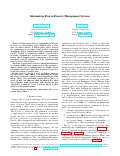Information Flow in Disaster Management Systems
by Achim D. Brucker and Dieter Hutter
 Collaborations between organizations in the public sector, e.g., fire brigades, polices, military units, is often done via liaison officers. A liaison officer liaises between two organizations by providing a single point of contact and ensuring the efficient communication and coordination of their activities. Usually an organization embeds a liaison officer in another organization to provide face-to-face coordination. Liaison officers demand special requirements to the security mechanism of the IT infrastructure of the organization that act as host for a liaison officer.
Collaborations between organizations in the public sector, e.g., fire brigades, polices, military units, is often done via liaison officers. A liaison officer liaises between two organizations by providing a single point of contact and ensuring the efficient communication and coordination of their activities. Usually an organization embeds a liaison officer in another organization to provide face-to-face coordination. Liaison officers demand special requirements to the security mechanism of the IT infrastructure of the organization that act as host for a liaison officer.
This holds, in particular, for Disaster Management Information Systems (DMIS). Such systems need, on the one hand, to support various ways of communication in a flexible and ad hoc manner. On the other hand, these systems need to protect, by law, the leakage of sensitive data.
In this paper, we present a novel mechanism, based on role-based access control (RBAC), for supporting the flexible and secure information exchange between organizations using liaison officers. Our mechanism enables liaison officers to decide on their own authority which information they wants share with their home organizations while allowing the host organization to limit the access of liaisons officers to their system in a fine-grained manner.
Keywords: disaster management, information flow, access control, liaison officer
Categories:
Documents: (full text as PDF file)
 Please cite this article as follows:
Please cite this article as follows:
Achim D. Brucker and Dieter Hutter.
Information Flow in Disaster Management Systems.
In International Conference on Availability, Reliability and Security (ARES), pages 156-163, IEEE Computer Society, 2010.
Keywords: disaster management, information flow, access control, liaison officer
(full text as PDF file) (BibTeX) (Endnote) (RIS) (Word) (doi:10.1109/ARES.2010.107) (

| abstract | = | {Collaborations between organizations in the public sector, e.g., fire brigades, polices, military units, is often done via liaison officers. A liaison officer liaises between two organizations by providing a single point of contact and ensuring the efficient communication and coordination of their activities. Usually an organization embeds a liaison officer in another organization to provide face-to-face coordination. Liaison officers demand special requirements to the security mechanism of the IT infrastructure of the organization that act as host for a liaison officer.\\\\This holds, in particular, for Disaster Management Information Systems (DMIS). Such systems need, on the one hand, to support various ways of communication in a flexible and ad hoc manner. On the other hand, these systems need to protect, by law, the leakage of sensitive data.\\\\In this paper, we present a novel mechanism, based on role-based access control (RBAC), for supporting the flexible and secure information exchange between organizations using liaison officers. Our mechanism enables liaison officers to decide on their own authority which information they wants share with their home organizations while allowing the host organization to limit the access of liaisons officers to their system in a fine-grained manner.}, | |
| address | = | {Los Alamitos, CA, USA}, | |
| author | = | {Achim D. Brucker and Dieter Hutter}, | |
| booktitle | = | {International Conference on Availability, Reliability and Security (ARES)}, | |
| doi | = | {10.1109/ARES.2010.107}, | |
| isbn | = | {978-0-7695-3965-2}, | |
| keywords | = | {disaster management, information flow, access control, liaison officer}, | |
| language | = | {USenglish}, | |
| pages | = | {156--163}, | |
| = | {https://www.brucker.ch/bibliography/download/2010/brucker.ea-information-2010.pdf}, | ||
| publisher | = | {IEEE Computer Society}, | |
| title | = | {Information Flow in Disaster Management Systems}, | |
| url | = | {https://www.brucker.ch/bibliography/abstract/brucker.ea-information-2010}, | |
| year | = | {2010}, |